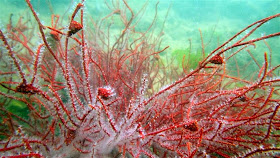On our last evening low tide, we revisited Tuas shore with hope to cross over to Merawang Beacon. We were not able to do so during our previous trip in December as the tide was higher than expected.
There was a bloom of Sea lettuce green seaweed (Ulva sp.) at several parts of the shore before the water channel separating the beacon and the main shore. At the background is Pulau Merambong belonging to Malaysia.
We were ready to get our underpants wet but the tide was somehow lower than expected. So it was more of a thigh level height that we encountered. Could it be a non-compliant tide or that the ground was "raised" by sediment deposition?
Here's Marcus and Pei Yan in the middle of the crossing. It was Pei Yan's birthday and she was glad to have celebrated on a special shore.
Though it looks like there's nothing from above, the water channel separate the beacon and the main shore is an underwater fan-tasy (made up of many sea fans)!
There are many Sea fans
(Order Gorgonacea) underneath the water and many of them are thick and huge. They look very beautiful submerged underwater as the whole area looks like an underwater garden.
I go a bit gaga when I see these pretty sea fans and thus will snap lots of photos. Here's another shot of this yellow sea fan with its tips almost touching the water surface.
This unidentified orange sea fan with white tentacles looks like a bouquet of flowers with a thick sturdy "trunk" at its base. It could be a Tree sea fan.
This maroon or dark-purple sea fan looks very fluffy with its polyps sticking out. It could be the Gnarled sea fan (Echinomuricea pulchra).
On one of the branches, I came across this tiny crab clinging onto the sea fan and before I could have a closer look, it fell into the water.
On top of the sea fans, there are also many colonies of these Starry leathery soft corals (Family Alcyoniidae).
I also saw many different types of Disk corals (Turbinaria sp.) on the shore. Here's a healthy-looking colony found underwater.
Some of these disk corals were really huge and are comparable in size with those found on the better reefs of the South.
Unfortunately, there were also some of these corals that looked bleached. Some others were overturned.
As we made it to the beacon without getting ourselves too wet, we had a look at what we could find around this landmark. One of my first sightings would be this large colony of disk coral with green fringes.
Interestingly, the green fringes are made up of seaweed that got stuck with the coral while floating in and out with the tide.
I came across one colony of the Small goniopora coral (Goniopora sp.) and it looks slightly bleached too. Could it be because of the recent increase in temperature? I have no idea.
Fortunately, the green and brown Boulder pore corals (Porites sp.) that I came across looked fine.
I was quite intrigued with the identity of this encrusting hard coral and later realised that it is like to be the Encrusting disk coral (Turbinaria sp.).
Among the sea fans, corals and sea weed, there were also several Long black sea cucumbers (Holothuria leucospilota) which are doing well on Tuas.
I was elated to find this pretty in pink semi-adult sized Cake sea star (Anthenea aspera). It was found near the beacon area.
On the other hand, Ria found this lone Biscuit sea star (Goniodiscaster scaber) with pretty penta-radial patterns. I also found out from Ria that Sheryl saw a Knobbly sea star (Protoreaster nodosus)!
While trying hard to relocate the knobbly sea star, I stumbled upon the Eight-armed sand star (Luidia maculata)!
In fact, we saw a total of four of these uncommon sea stars! That's quite a lot on a single trip.
For some unknown reasons, we also came across several of these dead test of heart urchins. Could this be due to a natural life cycle or season or due to anthropogenic effects such as pollution?
There were many of these small Ball flowery soft corals (Family Nephtheidae) on Tuas and they seem to remain small in size on this shore.
At the mouth of a burrow is this wriggly tiny fish which I have not seen before. It was actively moving around the edge of the burrow.
There was this lone sea hare found along the soft sediments and it looked like the Geographic sea hares (Syphonota geographica).
Marcus found two of these Bornella nudibranch (Bornella sp.) on the blade of seaweed and it is likely our first sighting on Tuas.
Here are more photos of the elegant sea fans underwater. :)
Alas on the trip, we saw several barges nearer to the Malaysian coast across the Johor Straits.
We believe that it is part of the construction to build Forest City just right across the shoreline of Tuas near the 2nd link. Let's hope that all these coastal development will not cause a significant impact the natural environment around the area.
More photos of the trip here: https://www.flickr.com/photos/koksheng/archives/date-taken/2015/03/19/
































No comments:
Post a Comment